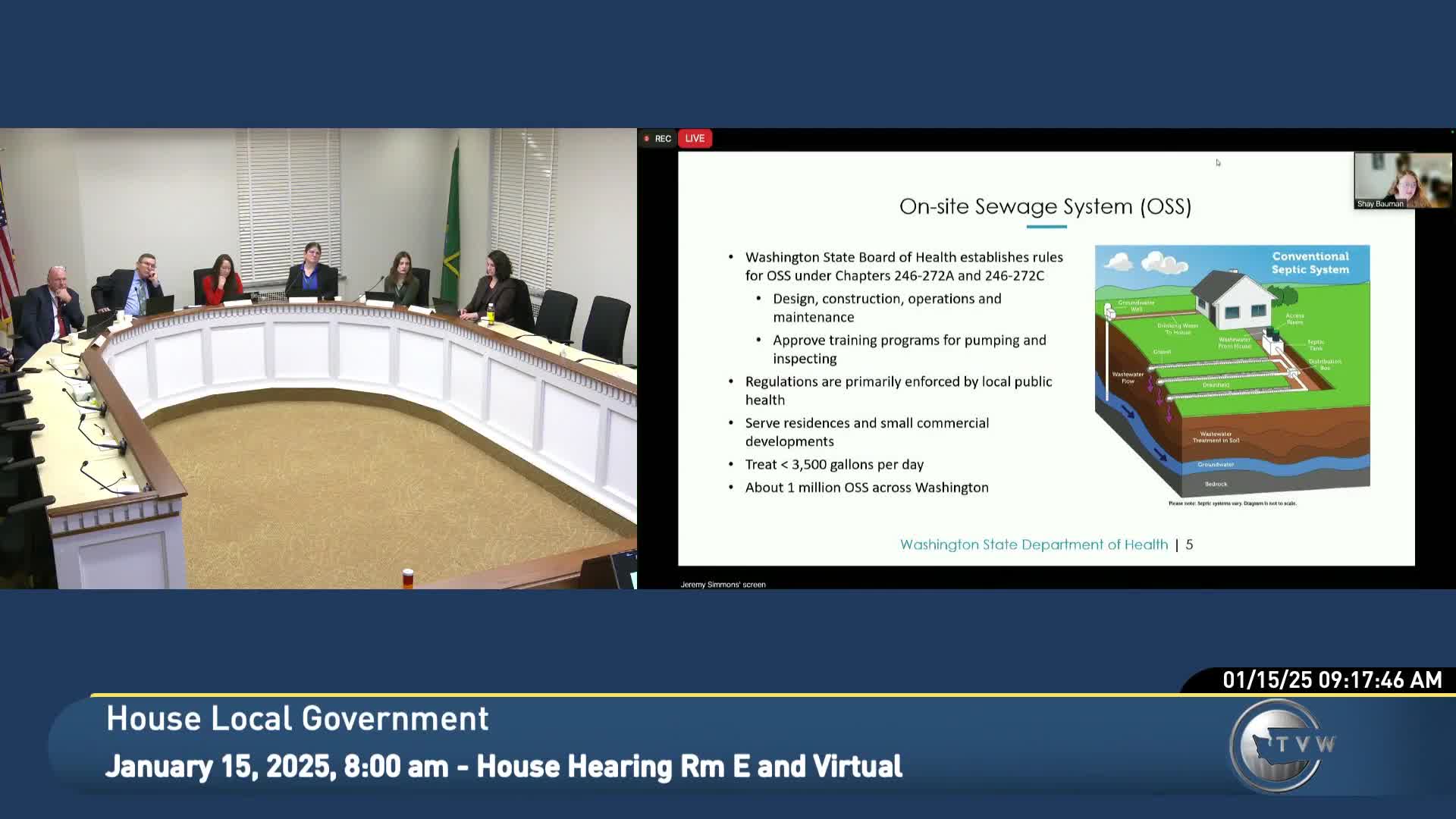State health officials outline septic rules, data gaps and costs; property-transfer inspections phased to 2027
January 15, 2025 | Local Government, House of Representatives, Legislative Sessions, Washington
This article was created by AI summarizing key points discussed. AI makes mistakes, so for full details and context, please refer to the video of the full meeting. Please report any errors so we can fix them. Report an error »

Jeremy Simmons, wastewater management section manager at the Washington State Department of Health, and Shay Bowman, policy adviser at the Washington State Board of Health, briefed the Local Government Committee on on-site sewage system rules, inspection requirements and management challenges.
"Washington has about a million of these systems," Bowman said, summarizing the scale of conventional septic systems that serve residences and small businesses and treat less than 3,500 gallons per day.
Officials outlined two rule sets: on-site sewage system rules in chapter 246-272A WAC (and tank rules in 246-272C WAC) that local health jurisdictions administer, and large on-site sewage system rules (identified in the presentation under chapter 246-272B and related statutory authority) that the Department of Health implements. Large on-site sewage systems, Simmons said, typically treat from 35,100 to several hundred thousand gallons per day and there are about 570 of the larger systems statewide.
Key points and recent changes:
- Rule revisions: The State Board of Health adopted significant rule updates in January 2024 covering local management plans, verification of proprietary products, property-transfer inspections and minimum lot sizes. Simmons and Bowman said the board's rulemaking began in 2018 and concluded with the January 2024 adoption.
- Property-transfer inspections: Simmons told the committee the board phased in a requirement that on-site systems be inspected on property transfers; "It will take effect, in July of 2027," he said, to allow smaller counties time to build capacity and secure service providers.
- Inspection frequency: Officials said conventional septic systems are required to be inspected every three years; systems with proprietary or more sophisticated technology typically require annual inspection.
- Known failures and data gaps: Simmons said Puget Sound counties logged just under 1,000 failing systems in the last two quarters of 2024, but that most of the state lacks comprehensive failure data.
Officials described recurring challenges: the high cost of installation and repairs for homeowners; limited county resources to carry out inspections and enforcement; difficulty sustaining owner education and outreach; and climate-related risks (saturated drainfields, sea-level rise for shoreline systems, wildfire damage). Simmons and Bowman said routine operation and maintenance are essential to avoid groundwater and surface-water contamination and more costly repairs.
Committee members asked about groundwater monitoring, DNA testing of contamination sources, permitting for engineered systems in deep soils, and strategies to improve owner awareness. Simmons said groundwater monitoring is largely conducted by the Department of Ecology and that DNA testing is not a routine, statewide tool because of cost; he said county programs typically pursue voluntary compliance or targeted enforcement when failures are found.
What's next: Health officials said they will continue training and technical assistance for local health jurisdictions and support public education. The board's property-transfer inspection requirement is phased to take effect in July 2027 to allow jurisdictions time to prepare.
"Washington has about a million of these systems," Bowman said, summarizing the scale of conventional septic systems that serve residences and small businesses and treat less than 3,500 gallons per day.
Officials outlined two rule sets: on-site sewage system rules in chapter 246-272A WAC (and tank rules in 246-272C WAC) that local health jurisdictions administer, and large on-site sewage system rules (identified in the presentation under chapter 246-272B and related statutory authority) that the Department of Health implements. Large on-site sewage systems, Simmons said, typically treat from 35,100 to several hundred thousand gallons per day and there are about 570 of the larger systems statewide.
Key points and recent changes:
- Rule revisions: The State Board of Health adopted significant rule updates in January 2024 covering local management plans, verification of proprietary products, property-transfer inspections and minimum lot sizes. Simmons and Bowman said the board's rulemaking began in 2018 and concluded with the January 2024 adoption.
- Property-transfer inspections: Simmons told the committee the board phased in a requirement that on-site systems be inspected on property transfers; "It will take effect, in July of 2027," he said, to allow smaller counties time to build capacity and secure service providers.
- Inspection frequency: Officials said conventional septic systems are required to be inspected every three years; systems with proprietary or more sophisticated technology typically require annual inspection.
- Known failures and data gaps: Simmons said Puget Sound counties logged just under 1,000 failing systems in the last two quarters of 2024, but that most of the state lacks comprehensive failure data.
Officials described recurring challenges: the high cost of installation and repairs for homeowners; limited county resources to carry out inspections and enforcement; difficulty sustaining owner education and outreach; and climate-related risks (saturated drainfields, sea-level rise for shoreline systems, wildfire damage). Simmons and Bowman said routine operation and maintenance are essential to avoid groundwater and surface-water contamination and more costly repairs.
Committee members asked about groundwater monitoring, DNA testing of contamination sources, permitting for engineered systems in deep soils, and strategies to improve owner awareness. Simmons said groundwater monitoring is largely conducted by the Department of Ecology and that DNA testing is not a routine, statewide tool because of cost; he said county programs typically pursue voluntary compliance or targeted enforcement when failures are found.
What's next: Health officials said they will continue training and technical assistance for local health jurisdictions and support public education. The board's property-transfer inspection requirement is phased to take effect in July 2027 to allow jurisdictions time to prepare.
View full meeting
This article is based on a recent meeting—watch the full video and explore the complete transcript for deeper insights into the discussion.
View full meeting
